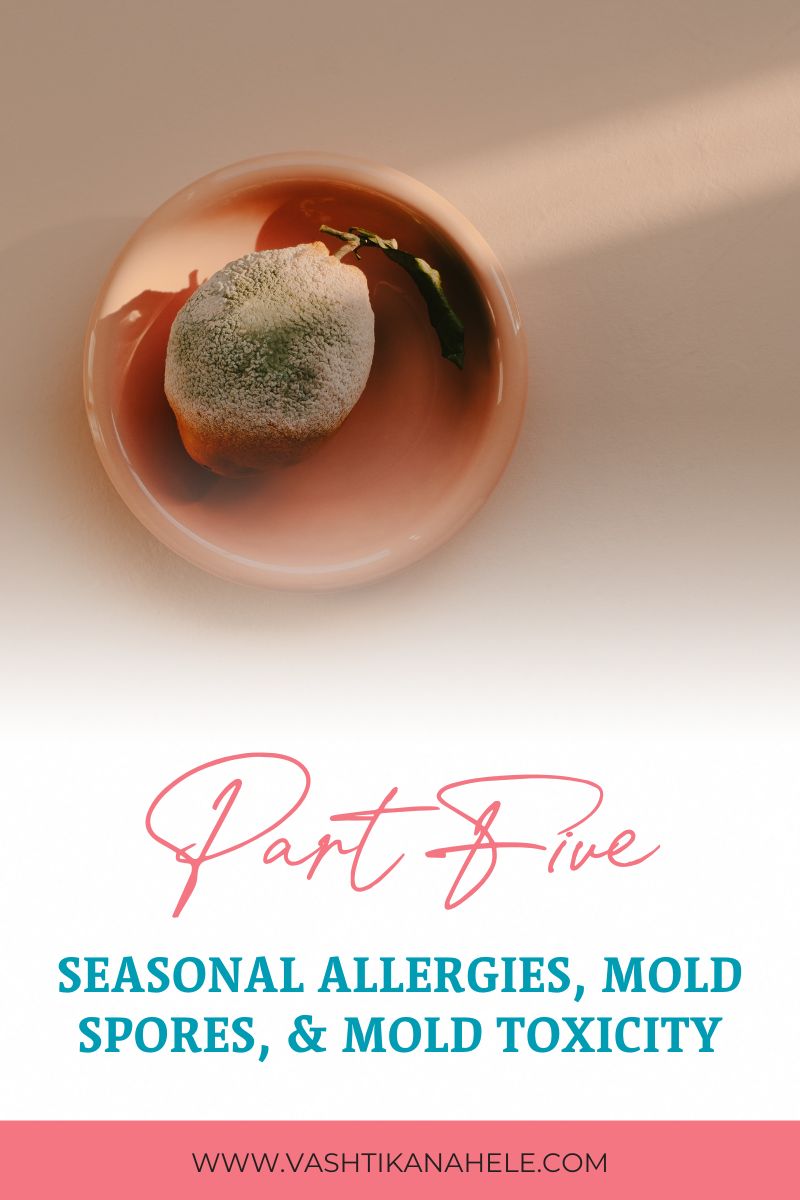Seasonal Allergies, Mold Spores, & Mold Toxicity
Part Five in Our Seasonal Allergy Blog Series
If you experience perennial or seasonal allergies and live with complex chronic illness, there’s a good chance mold toxicity and/or mold spore allergies could be at play. This is because mast cell activation syndrome/MCAS is a potential root cause of seasonal allergy symptoms — and complex chronic conditions such as mold sickness are common triggers for MCAS. Overlapping symptoms between MCAS, mold spore allergies, and mold sickness include sinus congestion, coughing, skin rashes, and shortness of breath, as well as other symptoms such as brain fog, fatigue, and muscle pain.
While mold toxicity, mold allergies, and MCAS don’t always occur simultaneously, it’s possible to experience one, two, or all three of these conditions. In some cases, histamine intolerance may also be present. Dysbiosis in the gut and impaired detoxification can make matters even worse!
Keep reading this post in our Seasonal Allergy Blog Series to learn more about mold as a potential root cause of allergy symptoms, and book a free Discovery Call with me if you think a past or current mold exposure could be the missing piece in your healing journey.
Differences Between Mold Spore Allergies & Mold Toxicity
As you may remember from the first post in our Seasonal Allergy Blog Series, mold spores — along with grass, tree pollen, smoke, and insect stings — are the most common seasonal allergens affecting more than 50 million Americans each year. An estimated 10 percent of individuals with allergies are sensitive to mold spores, specifically, and about five percent of these people experience symptoms related to mold exposure.
Symptoms of a mold allergy may include:
- Allergic rhinitis.
- Watery eyes.
- Coughing.
- Shortness of breath.
- Nose, skin, and throat irritation.
- Worsened asthma symptoms.
While those with allergies to mold spores typically experience a worsening of symptoms when exposed to indoor and outdoor molds (such as aspergillus, penicillium, cladosporium, and alternaria), their symptoms usually improve once they reduce mold exposure in their homes, lawns, vehicles, and workplaces. However, delayed reactions can also occur; symptoms of a mold allergy are not always immediate!
So for example, a person’s allergy symptoms may worsen when raking wet leaves in the spring, but they might feel better once they’re done raking and head back indoors. Or it’s possible that symptoms could be delayed by a few hours or days, or their symptoms may worsen over time.
Those with mold toxicity and mold biotoxin illness, however, tend to feel poorly pretty much all the time despite eating well and doing all the “right” things. This is because 25 percent of individuals are genetically unable to remove biotoxins from their bodies after exposure, which causes mold toxins (mycotoxins) to accumulate in the body with no way out. Dr. Fox and I see many of these patients in our practice!
Mold Toxicity Symptoms
Though some of the more common symptoms of mold toxicity include nonspecific symptoms like brain fog, anxiety, numbness, headaches, and unusual aches and pains, individuals may also experience typical allergy and asthma symptoms if they have mold toxicity and mold spore allergies. Mold can also colonize in the body — growing inside the sinuses, lungs, and gut — making mold toxicity symptoms and other complex medical conditions even worse.
Other clues that may indicate mold sickness include:
- Symptoms started shortly after moving into a home, buying a vehicle, or working in a new office.
- Living in a home with water damage, water leaks, or past flooding.
- Living in a home with a basement or crawlspace.
- Experiencing ongoing symptoms such as elevated cholesterol, depression, poor sleep, digestive issues, and cognitive impairment.
Unfortunately, mold triggers many complex chronic illnesses like Hashimoto’s thyroiditis, allergies, asthma, and various autoimmune conditions. It can also prevent you from healing from a complex chronic illness such as Lyme, other tick-borne infections, and viruses. But the good news is that mold toxicity is treatable!
Have Seasonal Allergies? Test for Mold Allergies & Mold Toxicity
To help you get to the root of your allergy symptoms, allergists can conduct blood and skin prick tests to determine whether you have a mold spore allergy, However, these tests only look for mold spore allergies and they do not detect whether you’re suffering from mold toxicity or mold colonization. For this reason, testing your home and body for mold and mycotoxins is our preferred first step as functional medicine providers.
Book a free 15-minute Discovery Call today to learn how functional medicine coaching can help you find the root cause of your allergy symptoms and get back your life!
Ready to heal from complex chronic illness so you can live each day with energy, effortless digestion, and good overall health? Schedule your Vital You Consult, book a call for the Vital Basics Method™, or visit my website to learn about how I can help you heal from mold biotoxin illness and other complex chronic conditions.
References:
- https://acaai.org/allergies/allergies-101/facts-stats/
- https://allergyasthmanetwork.org/allergies/mold-allergy/
- https://aafa.org/allergies/types-of-allergies/mold-allergy/
- Nathan, N. (2018). Toxic: Heal your body from mold toxicity, lyme disease, multiple chemical sensitivities, and chronic environmental illness. Victory Belt Publishing, Inc.
- Wentz, I. (2017). Hashimoto’s protocol. HarperOne.







Pingback: 3 Things to Know About Mold Remediation - Vashti Kanahele